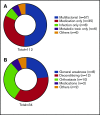Burden and impact of multifactorial geriatric syndromes in allogeneic hematopoietic cell transplantation for older adults
- PMID: 30606722
- PMCID: PMC6325300
- DOI: 10.1182/bloodadvances.2018028241
Burden and impact of multifactorial geriatric syndromes in allogeneic hematopoietic cell transplantation for older adults
Abstract
Multifactorial geriatric syndromes are highly prevalent in older patients with cancer. Because an increasing number of older patients undergo allogeneic hematopoietic stem cell transplantation (allo-HCT), we examined the incidence and impact of transplant-related geriatric syndromes using our institutional database and electronic medical records. We identified 527 patients age 60 years or older who had undergone first allo-HCT from 2001 to 2016 for hematologic malignancies. From the initiation of conditioning to 100 days posttransplant, new geriatric syndromes were predominantly delirium with a cumulative incidence of 21% (95% confidence interval [CI], 18%-25%) at day 100 followed by fall at 7% (95% CI, 5%-9%). In multivariable analyses of available pretransplant variables, fall within the last year, potentially inappropriate use of medication, thrombocytopenia, and reduced creatinine clearance were significantly associated with delirium; age older than 70 years and impaired activities of daily living were significantly associated with fall. In the 100-day landmark analysis, both delirium (hazard ratio [HR], 1.66; 95% CI, 1.09-2.52; P = .023) and fall (HR, 2.14; 95% CI, 1.16-3.95; P = .026) were significantly associated with increased nonrelapse mortality; moreover, fall (HR, 1.93; 95% CI, 1.18-3.14; P = .016), but not delirium, was significantly associated with reduced overall survival. Here, we establish baseline incidences and risk factors of common transplant-related geriatric syndromes. Importantly, we demonstrate significant associations of delirium and fall with inferior transplant outcomes. The burden and impact of transplant-related geriatric syndromes warrant the institution of patient-centered, preemptive, longitudinal, and multidisciplinary interventions to improve outcomes for older allo-HCT patients.
© 2019 by The American Society of Hematology.
Conflict of interest statement
Conflict-of-interest disclosure: The authors declare no competing financial interests.
Figures




Similar articles
-
Impact of geriatric vulnerabilities on allogeneic hematopoietic cell transplantation outcomes in older patients with hematologic malignancies.Bone Marrow Transplant. 2020 Jan;55(1):157-164. doi: 10.1038/s41409-019-0654-6. Epub 2019 Aug 30. Bone Marrow Transplant. 2020. PMID: 31471572 Free PMC article.
-
Haploidentical Hematopoietic Cell Transplant with Post-Transplant Cyclophosphamide and Peripheral Blood Stem Cell Grafts in Older Adults with Acute Myeloid Leukemia or Myelodysplastic Syndrome.Biol Blood Marrow Transplant. 2017 Oct;23(10):1736-1743. doi: 10.1016/j.bbmt.2017.06.019. Epub 2017 Jul 5. Biol Blood Marrow Transplant. 2017. PMID: 28688919
-
The geriatric syndrome of sarcopenia impacts allogeneic hematopoietic cell transplantation outcomes in older lymphoma patients.Leuk Lymphoma. 2020 Aug;61(8):1833-1841. doi: 10.1080/10428194.2020.1742909. Epub 2020 Mar 31. Leuk Lymphoma. 2020. PMID: 32228298 Free PMC article.
-
Assessment of older adult candidates for allogeneic hematopoietic cell transplantation: updates and remaining questions.Expert Rev Hematol. 2019 Feb;12(2):99-106. doi: 10.1080/17474086.2019.1568236. Epub 2019 Jan 22. Expert Rev Hematol. 2019. PMID: 30632411 Review.
-
Alloreactivity as therapeutic principle in the treatment of hematologic malignancies. Studies of clinical and immunologic aspects of allogeneic hematopoietic cell transplantation with nonmyeloablative conditioning.Dan Med Bull. 2007 May;54(2):112-39. Dan Med Bull. 2007. PMID: 17521527 Review.
Cited by
-
Potentially inappropriate medications in geriatric blood or marrow transplantation (BMT) survivors: A BMT Survivor Study report.Cancer. 2023 Feb 1;129(3):473-482. doi: 10.1002/cncr.34554. Epub 2022 Nov 22. Cancer. 2023. PMID: 36413424 Free PMC article.
-
Association of potentially inappropriate medications with prognosis among older patients with non-small cell lung cancer.BMC Geriatr. 2024 Jun 25;24(1):550. doi: 10.1186/s12877-024-05138-3. BMC Geriatr. 2024. PMID: 38918727 Free PMC article.
-
How old is too old? Frailty and geriatric assessments of older patients undergoing allogeneic HCT.Hematology Am Soc Hematol Educ Program. 2023 Dec 8;2023(1):709-714. doi: 10.1182/hematology.2023000457. Hematology Am Soc Hematol Educ Program. 2023. PMID: 38066893 Free PMC article.
-
Geriatric assessment in older alloHCT recipients: association of functional and cognitive impairment with outcomes.Blood Adv. 2020 Jun 23;4(12):2810-2820. doi: 10.1182/bloodadvances.2020001719. Blood Adv. 2020. PMID: 32574365 Free PMC article.
-
Characteristics and Impact of Post-Transplant Interdisciplinary Palliative Care Consultation in Older Allogeneic Hematopoietic Cell Transplant Recipients.J Palliat Med. 2020 Dec;23(12):1653-1657. doi: 10.1089/jpm.2019.0611. Epub 2020 Mar 27. J Palliat Med. 2020. PMID: 32216649 Free PMC article.
References
-
- Giralt SA. Hematopoietic cell transplantation for older adults. In: Korc-Grodzicki B, Tew WP, eds. Handbooks of Geriatrics Oncology – Practical Guide to Caring for the Older Cancer Patient New York, NY: Demos Medical Publishing; 2017:241-254.
-
- National Cancer Institute, Surveillance, Epidemiology, and End Results Program. SEER Stat Databases: November 2017 submission. https://seer.cancer.gov/data-software/documentation/seerstat. Accessed 15 July 2018.
-
- Pulte D, Jansen L, Castro FA, Brenner H. Changes in the survival of older patients with hematologic malignancies in the early 21st century. Cancer. 2016;122(13):2031-2040. - PubMed
-
- D’Souza A, Fretham C. Current uses and outcomes of hematopoietic cell transplantation (HCT): CIBMTR summary slides, 2017. http://www.cibmtr.org/ReferenceCenter/SlidesReports/SummarySlides/pages/.... Accessed 15 July 2018.
Publication types
MeSH terms
Grants and funding
LinkOut - more resources
Full Text Sources
Medical

